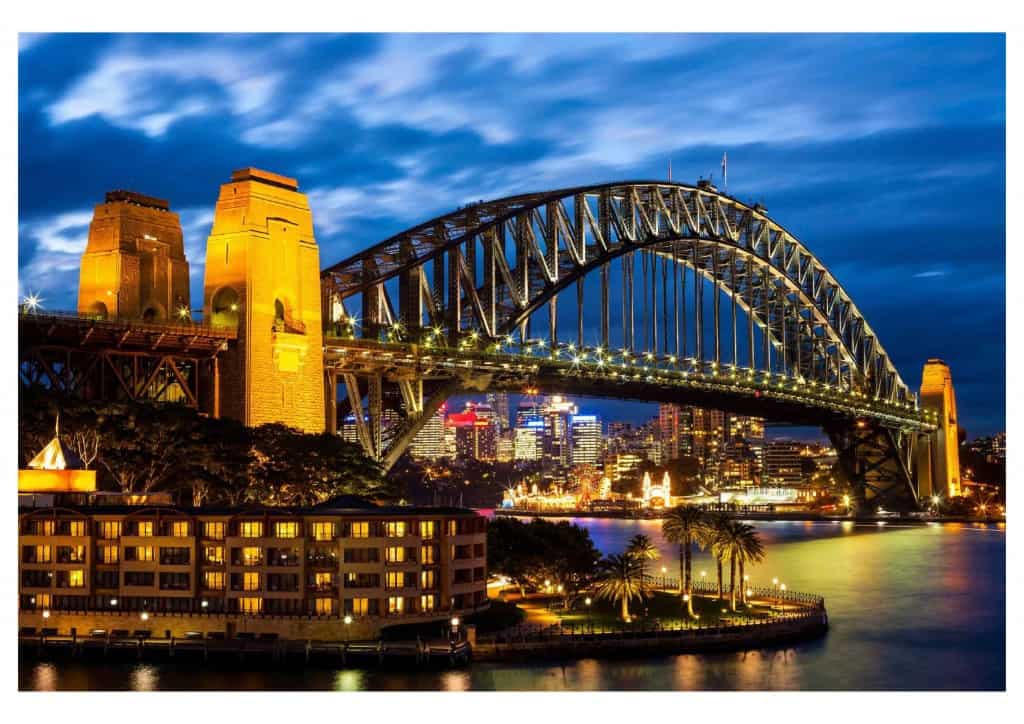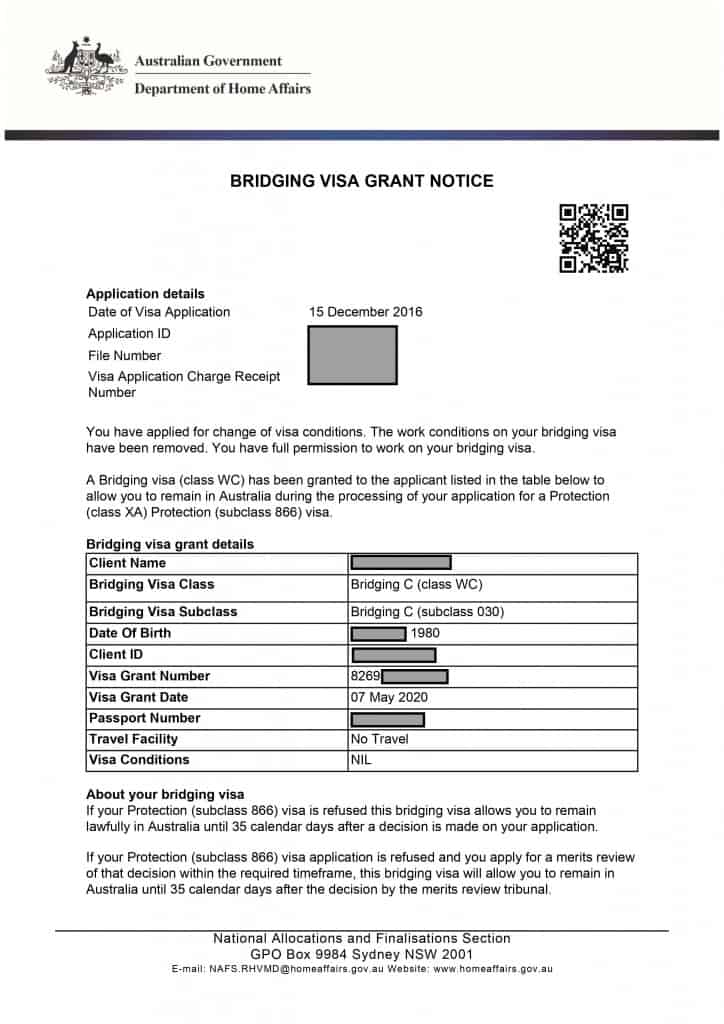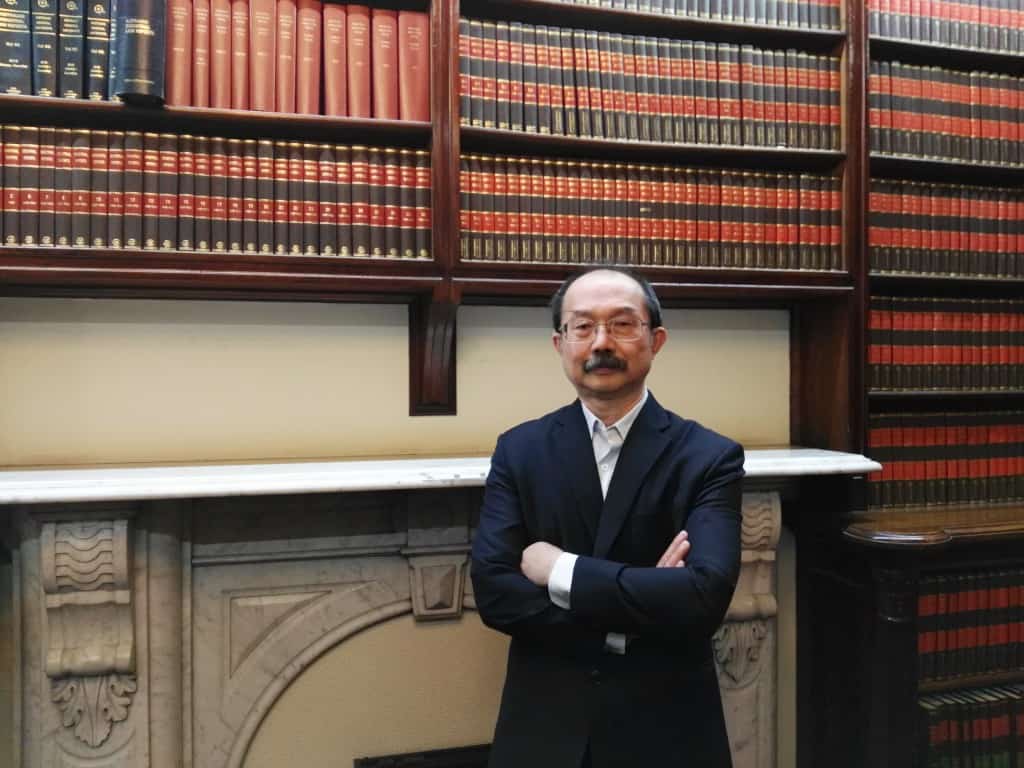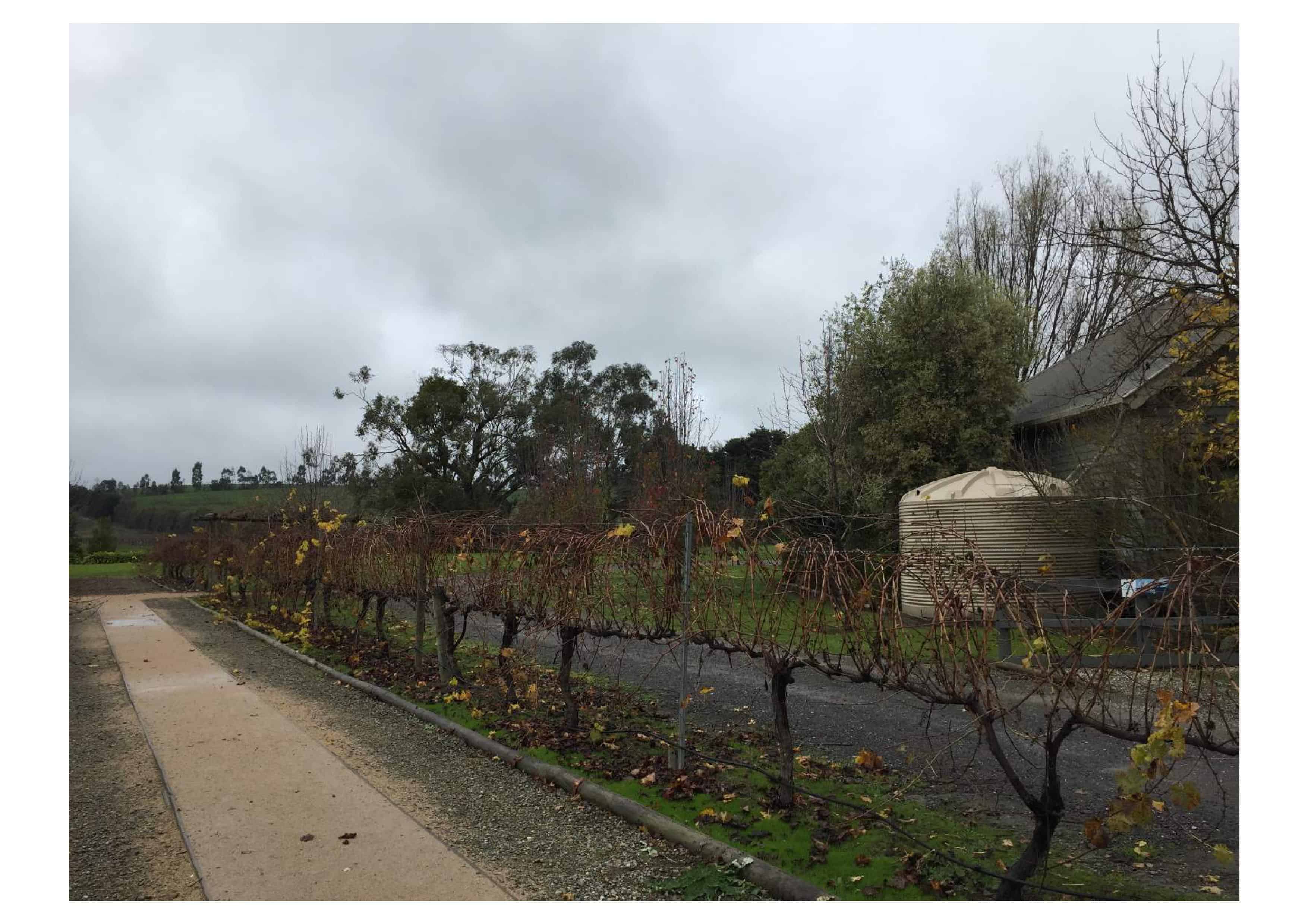
Bridging visa – the purpose of bridging visa is to provide lawful status for you to remain in Australia if you:
- have made (or intend to make) in Australia applications for substantive visas that have not been finally determined (BVA, BVB, BVC, BVD Subclass 040, BVE Subclass 050 and 051); or
- have applied for judicial review of a decision to refuse a substantive visa (BVA, BVB, BVC or BVE); or
- do not wish to, or are unable to apply for a substantive visa (BVD Subclass 041)
- must leave Australia during the processing of your substantive visa / judicial review application (BVB); or
- are suspected victim of human trafficking or slavery (BVF); or
- are in immigration detention and awaiting deportation (BVR); or
- are making arrangements to leave Australia (BVE Subclass 050); or
- are applying for a BVE Subclass 050 on the basis of:
- judicial review of a decision other than refusal of a visa application or
- revocation or review of a cancellation decision or
- review of a decision under the Australian Citizenship Act 2007 or
- ministerial intervention under s 351, s 417 or
- a determination under s 48B or a declaration that the Act does not apply to you
- are unlawful non-citizen and in criminal detention (BVE Subclass 050).
Bridging visa is not a substantive visa. A bridging visa, other than BVB (allow multiple travel during a specified period) and BVF (allowing one travel to Australia only), only allows you to remain in Australia and does not allow you to travel to and enter Australia.
Holding a bridging visa allow other visa applications
Holding a bridging visa does not prevent you from applying for a visa of another class. In certain circumstances while you are in Australia holding a BVA or a BVB or a BVC you may apply for:
- Class VB Subclass 887 Skilled Regional
- Class VC Subclass 485 Temporary Graduate
- Class SI Subclass 189 Skilled Independent
- Class SN Subclass 190 Nominated
- Class SP Subclass Regional Sponsored
- Class EA Subclass 132 Business Talent
- Class EC Subclass 888 Business Innovation and Investment
- Cass EB Subclass 188 Business Innovation and Investment
- Class EN Subclass 186 Employer Nominated
- Class RN Subclass 187 Regional Employer Nomination
List of bridging visas
- Class WA Subclass 010 BVA – granted to those holding or held a substantive visa and/or holds a BVA or BVB and applied for a further substantive visa that has not been finally determined (s 5(1)) or judicial review of a decision to refuse to grant that substantive visa.
- Class WB Subclass 020 BVB – granted to those holding BVA or BVB and has substantial reasons for leaving and re-entering Australia during either the processing of the associated substantive visa application or judicial review of a decision to refuse to grant that substantive visa.
- Class WC Subclass 030 BVC – granted to those who does not hold a substantive visa nor a BVE and has not held a BVE since last held a substantive visa. You must have applied for a substantive visa that has not been finally determined or judicial review of a decision to refuse to grant that substantive visa.
- Class WD Subclass 040 BVD (Prospective Applicant) – granted to an unlawful non-citizen who is not in immigration detention or criminal detention or who holds a visa that will cease within the next 3 working days and has unsuccessfully attempted to make a valid application for a substantive visa but would only be able to do so within 5 working days. This visa is valid for 5 working days. This visa can, in limited circumstances, be granted without application. You cannot be granted a BVD Subclass 40 if you have already been granted 2 since you last held a substantive visa.
- Class WD Subclass 041 BVD (Non-Applicant) – granted to unlawful non-citizen who is not in immigration detention or criminal detention and is either unable or does not want to apply for a substantive visa and an authorised officer is not available you
- Class WE Subclass 050 (General) – granted to an unlawful non-citizen or holder of either a BVE or BVD Subclass 041 who:
- is making arrangements to leave Australia or
- has made, or will soon make, a valid application for a substantive visa or
- has applied for judicial review or
- has applied, or will soon apply, for revocation or review of a cancellation decision or
- has apply for lifting of s 48A bar (s 48B) or
- has apply for ministerial intervention under s 351 or s 417 or
- has served a sentence of periodic detention or imprisonment or
- has applied for judicial review or merits review of a decision under the Australian Citizenship Act 2007 or
- the Minister has decided to substitute a more favourable decision for the decision of the AAT but cannot for the time being be granted that visa.
- Class WE Subclass 051 (PV Applicant) BVE – granted to those who has applied for a protection visa that has not been finally determined.
- Class WF Subclass 060 BVF – granted to those who has been identified by AFP or State/Territory police as being a suspected victim of human trafficking. You will normally be invited to apply and provided with suitable care.
- Class WR Subclass 070 (Pending Removal) BVR – granted to persons in immigration detention when removal from Australia is not reasonably practicable. You will normally be invited to apply through ministerial intervention under s 195A.
Who can be granted a bridging visa?
In order to be grant a bridging visa, you must be an eligible non-citizen. An eligible non-citizen is a person who has been immigration cleared or is a prescribed class of person or the Minister has determined you to be an eligible non-citizen.
Cannot apply for a bridging visa
You cannot apply for another visa if your visa was refused or cancelled under s 501, s 501A or s 501B. However, you can or granted a Subclass 070 BVR.
You cannot be granted a bridging visa if you applied for a protection visa that was refused because you have access to protection from third countries while you remain in the migration zone.
Similarly, you cannot apply for a bridging visa if you hold a criminal justice entry visa or remains in Australia after your criminal justice entry visa has been cancelled. You may be able to apply for a protection visa.
If you are in immigration detention and your last bridging visa BVE was refused, you can only make a further BVE application after 30 days unless the Minister is satisfied that you now satisfy the criteria for the grant.
How to apply for a bridging visa
BVA – you do not need to apply for this bridging visa as it will automatically be granted when you apply for a substantive visa. However, at the time you apply for the substantive visa, you must hold a valid substantive visa.
BVB – if you hold a BVA you may, depending on whether on the status of your substantive visa application, either lodge an internet application or paper application if you have a substantial need to travel.
BVC – you do not need to apply for this bridging visa as it will automatically be granted when you apply for a substantive visa. This visa is granted because at the time you apply for the substantive visa, you do not hold a valid substantive visa.
BVD – you can only lodge a paper application using form 1007.
BVE – normally apply through the internet.
BVF – you can only lodge a paper application using form 1239.
BVR – normally you are invited in writing by the Minister to apply according to one for s 494B methods and you must accept the invitation within 7 days.
Visa Application Charge
The only bridging visa that has a visa application charge or fee is BVB.
Ministerial intervention
If you are seeking ministerial intervention under s 351 or s 417 or requesting to lift s 48A bar (s 48B) you may be granted a Subclass 050 BVE.
Can a bridging visa be granted outside Australia?
The only bridging visa that can be granted outside Australia is a BVF if the application is made in accordance with reg. 2.20B(2)) and the applicant (including immediate family member) is a suspected victim of human trafficking.
Applying for a bridging visa in immigration detention
If you are in immigration detention, you cannot make a valid application for a BVA, BVB, BVC or BVD. You can only make a valid application for a BVE or a BVF.
Similarly, you cannot be in immigration detention when applying for or granting a BVR.
If you make a valid application for a BVE, a decision must be made on that application within 2 working days if you have been immigration cleared or is an eligible non-citizen referred to in reg 2.20(6) or 28 calendar days in any other case. These deadlines do not apply if a detention review officer has signed a declaration, within 2 working days after the BVE application is made, stating that they believe the applicant did not pass the character test (s 501(6)). In such cases the decision period is 90 calendar days.
If a decision is made within the above timeframes, you are taken to have been granted the BVE.
Applying for a bridging visa in criminal detention
If you are in criminal detention you cannot make a valid application for a BVA, BVB, BVC or BVD. But you can make a valid application for a BVE, BVF and BVR.
You are in criminal detention if you are serving a period of imprisonment or periodic detention and not holding a criminal justice certificate or stay warrant.
Associated bridging visa cannot be granted for an offshore visa
If you are outside Australia and applied for a substantive visa that can only be granted offshore, you will not be granted a BVA or BVC or BVE bridging visa.
If you are in Australia and you applied for a substantive visa that can only be granted while you are outside Australia, and you planned to remain in Australia until just before a decision is made then travel offshore for the visa grant, you will not be granted a BVA or BVC or BVE.
Ways of applying for a bridging visa
There are 3 ways to apply for a bridging visa, depending on your status, bridging visa class and the reason for applying.
- Applying for a BVA, BVC or BVE at the same time and on the same form as the associated substantive visa application
- Applying separately for a bridging visa using the bridging visa application form
- You are taken to have made a valid application for a specific bridging visa if you meet certain prescribed circumstances.
Bridging visa application automatically made
If you are in Australia and you make a substantive visa application that can be granted onshore, you also make an ‘automatic’ application for a BVA, BVC or BVE (depending on your circumstances and status).
Bridging visa applications made for other purposes
You can make a paper application for a bridging visa for a BVA, BVB, BVC and BVE to:
- Replace a BV of the same class
- To change conditions on existing BV
- When applying for judicial review
- To make a further BVE Subclass 051 if the initial application was deemed to be invalid or refused.
Child born to bridging visa applicant
If your child is born while you are on a bridging visa because your substantive visa application has not yet been decided, your child is taken to have applied for a visa of the same class as you and to have combined your child’s application with you.
If you and your partner have applied for a bridging visa, your child is taken to have applied for 2 bridging visas.
Applying for judicial review
If you applied for judicial review of the DHA’s decision to refuse to grant a substantive visa, you must apply for a further bridging visa during the judicial review process. A bridging visa you hold at the time of applying for judicial review will cease either 28 days after being notified of the AAT’s decision (if your bridging visa was granted before 19 November 2016) or 35 days after being notified of the AAT’s decision (if your bridging visa was granted on or after 19 November 2016).
If you applied for judicial review on the basis of a decision to grant a substantive visa, you may be granted a BVA, BVB or BVC. If the decision is not to refuse you a substantive visa, then you will be granted a BVE.
If you are granted a BVE Subclass 051, you may be required to agree to depart or be removed from Australia 28 days after your judicial review is completed.

Compelling need to work
If your bridging visa has a “No Work” – condition 8101 or “Restrict Work” condition you can apply to replace the bridging visa without the condition if you have a compelling need to work. Click here to learn how to apply for work rights.
Usually a BVA may have a condition that prevents or restricts you from working, you can apply for another BVA without the condition on compelling need to work grounds.
If your BVC has condition 8101 (No Work) imposed, you can apply for another BVC without the condition on compelling need to work grounds.
If your BVE Subclass 050 has a condition preventing or restricting work, you can apply to replace the BVE without the condition if your current BVE was granted if you applied for an onshore visa that could be granted in Australia or the Minister has substitute a more favourable decision by you cannot be granted a substantive visa for the time being and you have a compelling need to work.
If your BVE was granted on the basis you have applied for a Protection visa and condition 8101 was imposed, you must (i) satisfy the compelling need to work and (ii) provide an acceptable reason for delay in applying for the PV.
Bridging visa subclasses without ‘compelling need to work’
If you hold a BVB with condition 8101, or another condition restricting work, you will have to apply for a BVA without the condition to replace your BVB.
If you hold a BVD, condition 8101 is a mandatory condition that cannot be waived.
If you hold a BVE Subclass 051 and condition 8101 is imposed, there is no waiver to remove this condition.
When will a bridge visa ceased to be in effect?
Your bridging visa may be valid for a specific period (date-driven) or until a specified event happens (‘event-driver).
BVA, BVB, BVC, BVE Subclass 051 and BVR are ‘event-driven’ bridging visas. Whereas BVD Subclass 040 is ‘date-driven”. BVD Subclass 041, BVE Subclass 050 and BVF can either be “date-driven” or “event-driven”.
A bridging visa may also be cancelled or the holder is deported under s 200.
A bridging visa must be in effect for it to cease to be in effect when the holder departs Australia.
Your bridge visa will cease to be in effect when you are granted a substantive visa. In some cases, the bridging visa will go into hibernation even after a substantive visa is granted if that bridging visa period has not ended. For e.g. if you applied for say, Subclass 482 visa, and you were granted a BVA. While waiting for your Subclass 482 visa to be determined, you applied for a Subclass 500 visa. You were granted the Subclass 500 visa which will cause the BVA to cease to be in effect under s 82(3). When your Subclass 500 ceased or is cancelled, your BVA come back into effect under s 68(4).
Your bridging visa granted in association with a substantive visa application will cease under s 82(7A) if that substantive visa is granted (and not s 82(3)).
If your bridging visa is event-driven, it will cease 35 days after the occurrence of that event. Events include:
- A decision to refuse a substantive visa application
- The substantive visa application is invalid
- The AAT/IAA affirmed the DHA’s decision
- A decision on revocation of a visa cancellation
- Your AAT merits review application is invalid
- You withdraw your application for a substantive visa
- You withdraw your AAT application for merits review
If you are granted a bridging visa because you applied for judicial review, that visa will cease 28 days after you withdraw the judicial review, or your review has been completed.
If you are granted a BVE Subclass 050 in relation to an application for revocation of the cancellation of a visa, the BVE will cease 14 working day after a decision or purported decision not to revoke or the application for revocation has been withdrawn.
Most beneficial bridging visas
- BVB
- BVA
- BVC
- BVD
- BVR
- BVE
- BVF
Notification of bridging visa application
Once the DHA make its decision, you will be notified of that decision to grant or refuse you the visa in the prescribed way unless the refusal is under s 501, s 501A, s 501B or s 501B or s 501F.
Effect on a bridging visa if substantive visa is cancelled
If you hold a substantive visa that was granted before a bridging visa was granted, that bridging visa will cease to be in effect on the cancellation of the substantive visa whether or not the bridging visa has come into effect or is out of effect and provided that substantive visa is not cancelled under s 501, s 501A or s 501B, otherwise the bridging visa is deemed to be have been cancelled. A deemed cancellation of the bridging visa is not a merits-reviewable decision.
If your substantive visa is cancelled, not under s 501, s 501A or s 501B, that was granted after a bridging visa was granted, that bridging visa will not cease to be in effect. For e.g. while on a Tourist visa you applied for a protection visa and a BVA was granted in association with the protection visa application. You then applied for and was granted a Student visa. While your protection visa is still being processed, your Student visa was cancelled under s 116. Your BVA that was granted in association with the protection visa application does not cease because at the time your BVA started you did not hold the Student visa.
If your substantive visa (and you were granted a bridging visa) is cancelled under s 116 is set aside by the AAT, you will need to apply for another bridging visa if you intend to apply for another substantive visa.
Appealing bridging visa refusal or cancellation
Your bridging visa application is refused, or your bridging visa is cancelled, you may be able to apply to the AAT for a merits review under s 338(2) or s 338(4).
A decision by the AAT to affirm the DHA’s decision tor refuse to grant or to cancel a bridging is judicially reviewable in the FCC. Application to the Court must be made within 35 days, unless you are granted an extension, of the date of the decision.
Changing Bridging Visa
Generally, the Department does not have a discretion to change your bridging visa from, say, BVE to BVA so that you can apply for a BVB to allow you to travel in an emergency.
Similarly, if you are currently holding a BVE and you are permitted to apply for another substantive visa, you will not be granted a BVA. A BVA is usually granted to an applicant who holds a substantive visa at the time of making an application for another substantive visa.
Australian migration law is complex and difficult to understand, contact our immigration lawyer for a consultation (fee applies) to help you decide which is the best bridging visa for you or click here to explore other visa options.

 041 222 4020 or WeChat: AUDvisa
041 222 4020 or WeChat: AUDvisa
This article is not intended to be or taken as migration legal advice. The author of this article disclaims any liability for any action or omission on the information provided or not provided in this article. You should always consult an immigration lawyer or a registered migration agent to form an informed opinion on your immigration matter.



